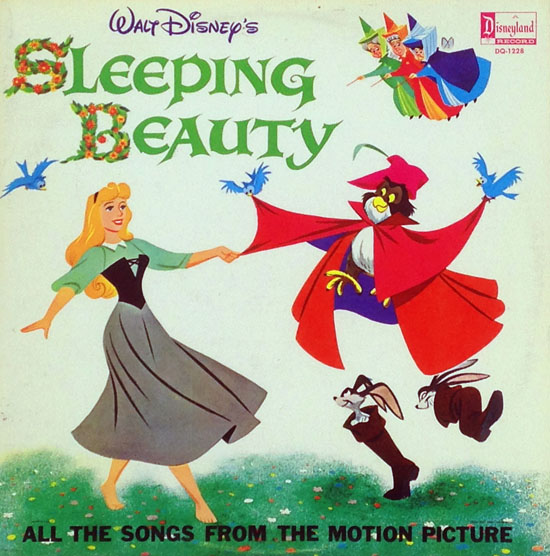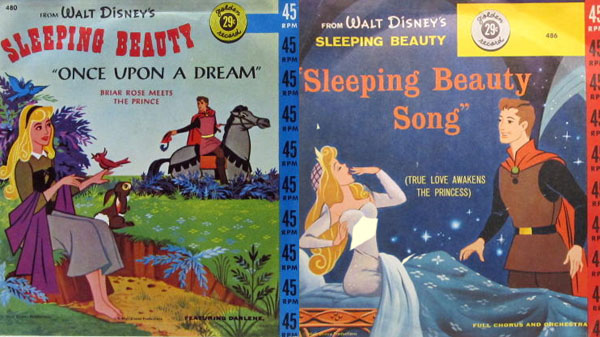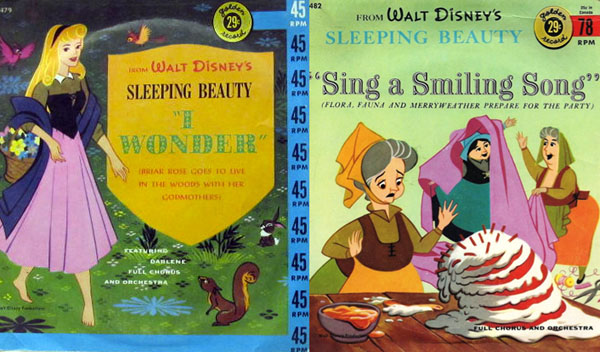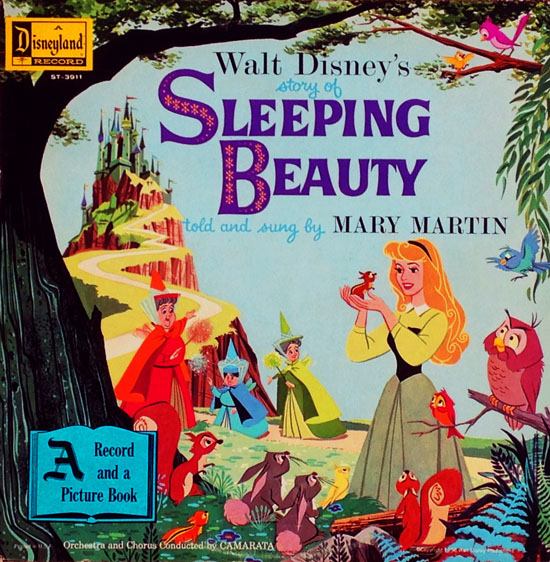A Broadway legend makes magic and a Mouseketeer inspires mystery in recordings based on Walt Disney’s Sleeping Beauty.

SONGS FROM WALT DISNEY’S SLEEPING BEAUTY
Camarata Orchestra and Chorus with Solos by Darlene Gillespie
Golden Records 6” 78 and 7” 45 RPM Records (Mono / 1958):
• I Wonder / Briar Rose Goes to Live in the Forest with the Godmothers #479
• Once Upon a Dream / Briar Rose Meets the Prince #480
• Hail to the Princess Aurora / The Princess is Born #481
• Sing a Smiling Song / Flora, Fauna and Merryweather Prepare for the Party #482
• Skumps / The Two Kings Plan a Wedding #483
• Sleeping Beauty Song / True Love Awakens the Princess #486
Disney LP Releases:
Official Mickey Mouse Club Records MM-32 (12” 33 1/3 RPM / Mono / 1959)
Reissue: Disneyland Records DQ-1228 ( 12” 33 1/3 RPM / Mono / 1962)
Executive Producer: Jimmy Johnson. Producer/Musical Director: Camarata. Running Time: 17 minutes.
Performers: Darlene Gillespie, Gloria Wood, Robert Harter, Disney Studio Vocalists.
Songs: (adapted from the Tchaikovsky ballet): “Hail to the Princess Aurora,” “Sing a Smiling Song” and “Sleeping Beauty Song” by Tom Adair and George Bruns; “I Wonder” by Winston Hibler, George Bruns and Ted Sears; “Once Upon A Dream” by Sammy Fain and Jack Lawrence; “Skumps” by Ed Penner, Tom Adair and George Bruns.
When Walt Disney’s Sleeping Beauty was still in production, the anticipation, promotion and merchandise were already gaining momentum. Years before the 1959 film release, TV’s Mickey Mouse Club presented Helene Stanley—the actress who played Polly Crockett and was the live-action model for Cinderella—on “Guest Star Day” (Remember? Mouseketeer #1: “MY Cinderella.” Mouseketeer #2: “MY Polly Crockett.” Stanley: “MY fan club!”). Miming to an audio track of the “Once Upon a Dream” sequence, Stanley demonstrated how she was currently modeling the movements for Aurora.
The common practice at the Disney Studios back then (and now, depending on the project) was to release books, comics, recordings and such to stores many months in advance of the film’s opening. (Personally, I love that.) So it was no surprise to see what was reported to be fourteen separate Sleeping Beauty records preceding the film.
One of them was the last album in the line of Official Mickey Mouse Club Records, a label originally distributed by ABC’s Am-Par division and later by Disneyland Records. According to R. Michael Murray’s The Golden Age of Walt Disney Records, a Shaggy Dog record was to follow Sleeping Beauty, but it ended up on the Disneyland label. This was the same period that Disneyland Records re-branded itself exclusively as a children’s product and the Buena Vista label was established to handle mainstream pop, R & B, easy listening, classical, soundtracks, etc. much as Hollywood Records does today.
Six Little Golden Records were also released, each featuring one song from Sleeping Beauty and one portion of the story, narrated by Darlene Gillespie. You would think the Mickey Mouse Club LP album would contain all the material from all six records. But herein lies the mystery.



On the LP, which is only 17 minutes long, Darlene’s narration is only heard before “I Wonder” and “Once Upon a Dream.” The back cover lists “Darlene Gillespie as Briar Rose,” but her narration is done in third-person. Maybe it was decided to include Darlene’s narration with the songs upon which she sings. Maybe it was to encourage the purchase of all six Golden Records or the Mary Martin Storyteller.
Three years later, this album was reissued, still including only two Darlene segments. This version was eventually deleted altogether and a condensed version of the film soundtrack was packaged under the same catalog number and cover art—but at the bottom, the copy was changed from “All the Songs from the Motion Picture” to “Music from the Original Motion Picture Sound Track.” The back cover also reflected the changes in content, but the overall back cover was similar as well.
GIVE A LITTLE LISTEN
“Darlene and Mary”
Darlene Gillespie sings “Once Upon a Dream” in her own, winsome way, with a segue to the contralto performance of Mary Martin. A full orchestra conducted by Camarata richly adorns both.
Both the Darlene and Mary Martin Sleeping Beauty records contains the same renditions of “Hail to the Princess Aurora” and “Skumps,” though they are slightly edited on the Darlene discs.
GIVE A LITTLE LISTEN
“Skumps”
Tutti Camarata’s version of “Skumps (The Drinking Song)” is of particular interest as it is presented as a big production number, rather than the short duet in the finished film. It’s fun to imagine how this approach might have worked.

WALT DISNEY’S STORY OF SLEEPING BEAUTY
Told and Sung by Mary Martin
With Orchestra and Chorus Conducted by Camarata
Disneyland Records Storyteller Series ST-3911 (12” 33 1/3 RPM with Book / Mono / 1958; Reissued 1969)
Executive Producer: Jimmy Johnson. Producer/Musical Director: Camarata. Running Time: 33 minutes.
Songs (adapted from the Tchaikovsky ballet): “Hail to the Princess Aurora,” “Sing a Smiling Song” by Tom Adair and George Bruns; “I Wonder” by Winston Hibler, George Bruns and Ted Sears; “Once Upon A Dream” by Sammy Fain and Jack Lawrence; “Skumps” by Ed Penner, Tom Adair and George Bruns.
Ah, for the days when children’s records had scope and majesty such as this! The box office performance for Sleeping Beauty was a game changer, not only for Disney animation, but also clearly for its Disney records. There was never again such a lavish non-soundtrack Storyteller. To be fair, it wasn’t only the film’s grosses that changed the budgets, it was also the change in the music business, as TV and rock & roll was now competing with records for kids’ attention.
Camarata may have recorded this music (as well as the music for the Mickey Mouse Club/Golden releases) in Berlin, Germany, where the Symphonie Orchester Graunke played for the Sleeping Beauty soundtrack under the baton of George Bruns (the orchestra also played for Disney’s Grand Canyon soundtrack). Mary Martin, then one of Broadway and TV’s biggest superstars, was a few months away from originating the role of Maria Von Trapp in The Sound of Music, the very last Rodgers and Hammerstein show, which was conceived specifically for her.
Martin’s narration (which was scripted a tad differently from Darlene’s) was surely recorded apart from the orchestra, but Camarata had it scored to compliment her performance precisely. It would not be a stretch to state that his scoring sounds magnificent enough to have been the actual film soundtrack. There are even some incidental melodies created for the record that are not part of Bruns’ score.
Both albums include vocals of “Sing a Smiling Song,” a tune heard only instrumentally in the movie, during the cake and dress making sequence. Gloria Wood “doubles” her voice for the Mickey Mouse Club LP track and Mary Martin does the same for her album. “Sleeping Beauty Song” is only heard on the MMC and Golden recordings.
Camarata did such an outstanding, feature film-worthy job on the music for this album, it makes one wonder if Walt himself listened to it and gave Tutti the opportunity to score some movies. He told me that he found film scoring less appealing than creating music for records, even though he did great vocal arrangements for Summer Magic, The Parent Trap, The Three Lives of Thomasina and the Oscar-nominated Symposium on Popular Songs.
GIVE A LITTLE LISTEN
“The Triumph of Good Over Evil”
The climactic battle between Prince Phillip and the dragon Maleficent is fully realized in audio by Mary Martin’s performance and the music conducted by Camarata. Note that the finale music is Tchaikovsky’s waltz and not “Once Upon a Dream.”


 GREG EHRBAR is a freelance writer/producer for television, advertising, books, theme parks and stage. Greg has worked on content for such studios as Disney, Warner and Universal, with some of Hollywood’s biggest stars. His numerous books include Mouse Tracks: The Story of Walt Disney Records (with Tim Hollis). Visit
GREG EHRBAR is a freelance writer/producer for television, advertising, books, theme parks and stage. Greg has worked on content for such studios as Disney, Warner and Universal, with some of Hollywood’s biggest stars. His numerous books include Mouse Tracks: The Story of Walt Disney Records (with Tim Hollis). Visit 





















































I wonder why Mary Martin did the songs for these records and not the movie, and why Mary Costa was chosen to perform the voice of Aurora for the movie. Why the two separate performers? Do you have any information about that? Was that a common thing for them to do?
Mary Costa, at the time a very popular singer on stage and television (you can see her on the Bing Crosby Christmas DVD set), was selected by Walt for several reasons, one being that her voice had remarkable clarity even in the high notes. Disneyland Records made it a practice to create a complete line of records to tie in with a film, some soundtracks and some not.
Mary Martin was a longtime friend and collaborator of Tutti Camarata and did several Disneyland albums with him (I’ll cover them in future Animation Spins). The decision was made pretty much to created a variety of recordings, as it was also popular for musical scores and hit songs to be “covered” by multiple artists. BTW, Mary Martin was among the actresses Walt considered for the role of Mary Poppins.
very often, the Disney records produced abroad were also different. A Sleeping Beauty Storyteller with soundtrack music and narration by Sheila Dunn. It had the same catalog number, ST-3911, but Mary Martin’s name was of course not on the cover.
The actual soundtrack was first issued on Disneyland Records in 1959, in both mono (WDL-4018) and stereo (STER-4018). One of the very first film soundtracks released on stereo LP, in fact.
That’s true, Paul. Randy Thornton also produced a lengthier soundtrack album which is still available. There’s also a soundtrack for the new Maleficent movie.
I own a golden book from 1956, it’s about Mickey solving a mystery at the club. Malicifent makes an appearance.
The narrator was a male in the movie. I think it would have been that way for the Storyteller edition albums, don’t you?